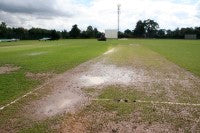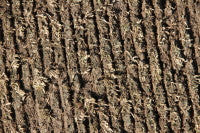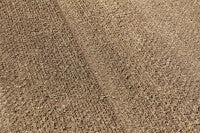Cricket Renovations 2012 (part one)
 Attending the Dennis/Sisis Groundsmans Seminar at the Swalec Stadium in September gave me the opportunity to hear, at first hand, some of the trials and tribulations many of our practising cricket groundsmen faced during one of the wettest summers on record.
Attending the Dennis/Sisis Groundsmans Seminar at the Swalec Stadium in September gave me the opportunity to hear, at first hand, some of the trials and tribulations many of our practising cricket groundsmen faced during one of the wettest summers on record.
The chief executive of Glamorgan CCC, Alan Harmer, stated, in his welcome speech to the 130 plus assembled groundsmen, how the weather had affected Glamorgan's playing season considerably, losing many hours/overs in a number of matches played at the SWALEC.
He was full of praise for the work of the club's head groundsman, Keith Exton, and his staff for coping with the adverse weather, especially the many hours they spent moving covers on and off the square.
I t was the same the country over. Many of the delegates had faced similar problems, and trying to keep matches on, usually with less equipment and manpower, had been a real strain. Clubs reported they had lost, on average, a third of their fixtures to the weather, with the resultant loss in revenue through clubhouse takings, match fees and subscriptions.
t was the same the country over. Many of the delegates had faced similar problems, and trying to keep matches on, usually with less equipment and manpower, had been a real strain. Clubs reported they had lost, on average, a third of their fixtures to the weather, with the resultant loss in revenue through clubhouse takings, match fees and subscriptions.
This has led many clubs to look at reducing their input into their own renovation programme to try and save money. The ECB were keen to advise clubs not to reduce or skimp on their end of season renovation programmes as this could lead to further problems in the future.
As one ECB Pitch adviser pointed out; "this has been an extremely difficult season for cricket groundsmen across the whole of the country. We began with drought conditions pre-season, followed by incessant and heavy rainfall for much of the first half of the season. I can particularly remember a run of seven wet Fridays on the trot where I am based in leafy Warwickshire."
 With income streams severely affected, I heard of cost-cutting measures where essential ground maintenance was concerned. Some clubs reported that they had only used 75% of their pitches on the square and, therefore, did not plan to renovate the unused ones - how wrong can they be!
With income streams severely affected, I heard of cost-cutting measures where essential ground maintenance was concerned. Some clubs reported that they had only used 75% of their pitches on the square and, therefore, did not plan to renovate the unused ones - how wrong can they be!
Pitches that have not been prepared for matches will not have been cut short or thinned out by verticutting/scarification and therefore, there will be a significant build-up of thatch and fibre. In fact, the unused pitches will probably need more attention than usual, with an extra pass of the heavy-duty scarifier in the autumn. DO NOT SKIMP ON VIGOROUS SCARIFICATION!!!
In my opinion, an application of autumn/winter fertiliser should be applied (probably 2 x 20kgs bags for an average ten pitch square) and the same applies for an overseeding programme, with dwarf perennial ryegrass ( probably 2 x 20 kgs bags for 10 pitch square).
 Bare pitch ends must be re-seeded with a dwarf perennial rye grass mixture and topdressed with a proprietary cricket loam. Where clubs can save money is on a 100% topdressing of their square - concentrate on the pitch ends only, but only for one year, or else there is the risk of saddles. On a typical ten pitch square this equates to around 60 x 25kgs bags of proprietary loam - a cost saving of around £275 to £300.
Bare pitch ends must be re-seeded with a dwarf perennial rye grass mixture and topdressed with a proprietary cricket loam. Where clubs can save money is on a 100% topdressing of their square - concentrate on the pitch ends only, but only for one year, or else there is the risk of saddles. On a typical ten pitch square this equates to around 60 x 25kgs bags of proprietary loam - a cost saving of around £275 to £300.
The message is clearly; skimp at your own peril, because neglect in the autumn renovation programme will mean inferior pitches the following season.
All clubs will have their own methods of working and renovating their squares. In most cases the level of work will be dictated by what budgets and resources are available at the time and what they are trying to achieve.
Make sure your machinery is up to the task with regular services.
Most club groundsmen are putting on between 6-10 bags of loam per pitch. It is important not to under or over-dress your tracks. Even in the current economic climate, it is best not to skimp on the amount of loam used.
I see too many club tracks that do not perform in terms of pace and bounce because of poor end of season renovation practices.
Generally, it is usually a combination of two factors that, when comb ined, causes problems - not removing enough thatch or organic material during renovations and spreading insufficient loam down to increase the bulk density of the soil profile.
ined, causes problems - not removing enough thatch or organic material during renovations and spreading insufficient loam down to increase the bulk density of the soil profile.
Scarification is important to remove unwanted vegetation, but also to produce a key for the new loam material to sit in. The level of scarification required will be dependent on how much of a thatch layer you have generated throughout the season. This year, has seen periods of heavy rain followed by high temperatures and grass growth has been prolific.
Thatch content, therefore, is likely to be on the high side. The best way to identify how much you have is by taking a core sample. It will then be a case of going through a vigorous renovation programme, scarifying in at least three directions, finishing in the line of play.
Where necessary, clean off all the thatch debris after each pass. The square can then be oversown using a suitable grass seed mixture; do not be frightened to try out new cultivars. Sowing rates now range between 35-50 grammes per square metre. In essence you are aiming to establish new grasses into your square.
